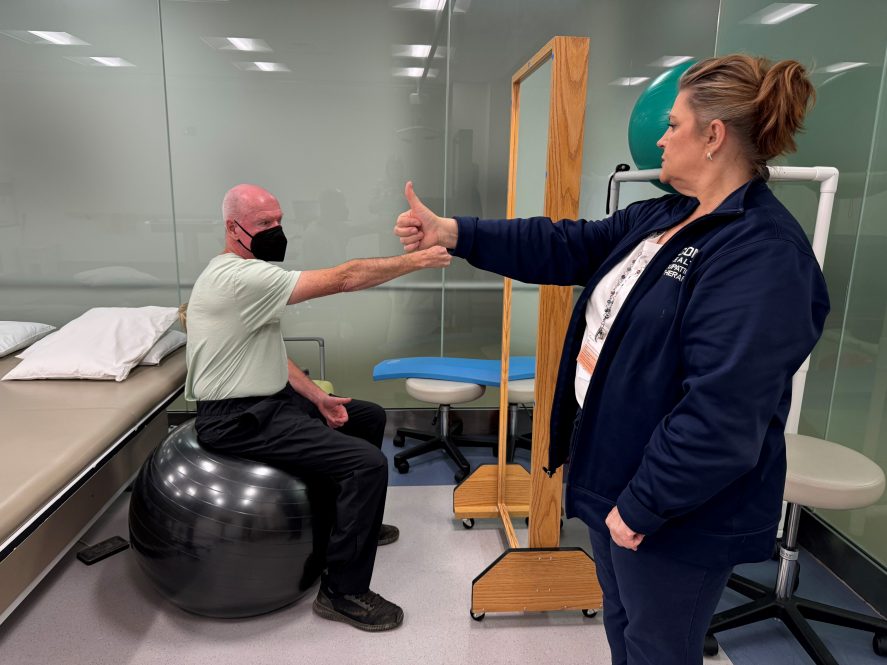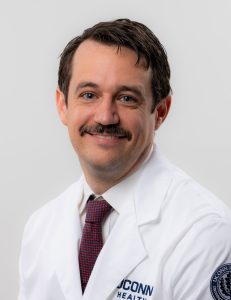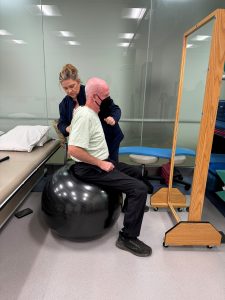Ernie Quinn, a stroke survivor, is experiencing remarkable progress in his recovery, thanks to the innovative Vivistem Paired VNS (Vagus Nerve Stimulation) System, currently only offered at UConn Health.

Ernie Quinn works with therapist Rhonda Hickey during occupational therapy. (Photo: Jennifer Walker, UConn Health)
In May of 2024, UConn Health became the first and only health system in Connecticut to implant a device intended to improve upper body mobility in patients who have experienced a debilitating stroke.

Dr. Christopher Conner, neurosurgeon at UConn Health's Brain and Spine Institute, was the first to use the MicroTransponder®, Inc.'s Vivistim® Paired VNS™ System, an FDA-approved, breakthrough technology for stroke survivors experiencing ongoing hand and arm impairment.
"Stroke is one of the leading causes of disability in people over the age of 60. It is a common condition, and most patients who have had a stroke have not recovered as much as they desire," says Conner.
Since May, he has treated several patients who are seeing great progress with the Vivistem which is a small device is implanted in a patient's upper chest, delivering vagus nerve stimulation (VNS) during rehabilitation therapy. The pairing of rehabilitation exercise with VNS creates or strengthens nerve connections in healthy areas of the brain, which increases the effectiveness of the therapy and has been shown to improve upper limb function.
"This may not get people back to 100%, but if you can help them regain the ability to perform activities of daily living on their own, it's a game-changing event," says Conner.
Ernie Quinn suffered from an ischemic stroke on December 28, 2023, he spent time in rehabilitation and completed speech, physical and occupational therapy. In June, he found himself plateauing. Many Ischemic stroke survivors have long-term loss of mobility and strength making routine tasks feel nearly impossible; and, like most stroke survivors, rehabilitation therapy eventually plateaus.
A google search on AI indicated vagus nerve stimulation (VNS) may be his next option so he googled New England VNS and found the article First in Connecticut: Ischemic Stroke Survivors Have Renewed Hope with the Vagus Nerve Stimulation Device Now Available at UConn Health on UConn Today. Intrigued he and his wife decided to explore this option and was referred to Conner.
"What I really liked about Dr. Conner is that he was very straightforward," says Quinn.
He had the surgery in August and soon began intensive occupational therapy for an hour and a half-long session three times a week for six weeks, at UConn Health's Neurorehabilitation with Rhonda Hickey.

During his therapy sessions, Hickey uses a wireless remote to activate the Vivistim device to deliver a gentle pulse to the vagus nerve while Quinn performs a specific task, such as buttoning a shirt, putting coins in a bank or moving around items like the work he does on his farm.
The simultaneous pairing of the rehabilitation exercise with vagus nerve stimulation releases neuromodulators that help create or strengthen neural connections to improve upper limb function and increase the relevance of physical or occupational therapy
"Many of the patients start to notice improvement within a couple of weeks and by the end of six weeks, they're making a lot of gains," says Hickey.
Quinn has graduated from the intensive program and is able to continue his progress through a self-directed, home-based stroke rehabilitation program using a magnet to activate the Vivistim System daily. He continues his physical therapy at UConn Health to help with lower body strength.
Quinn sees a great deal of progression as the stroke affected his left side. His is now able to open and close his hands all the way and his hand and arm movement have come a long way since receiving the VNS and participating in the rehabilitative therapy. He has a set routine on his farm he starts every morning incorporating his exercises and he is even back to golfing.
This innovative new technology now offers patients the chance to improve their recovery even after significant time has passed.
UConn Health, through the world class Brain and Spine Institute, has a long-standing history of being a leader in comprehensive stroke care in Connecticut. A multi-disciplinary team of experts provides fast, efficient care for patients experiencing symptoms of stroke and personalized, ongoing care for patients who have already experienced a stroke or have other risk factors. UConn Health is dedicated to bringing leading edge, potentially life changing treatment approaches to stroke survivors by ensuring patients have access to innovative therapeutic options.






